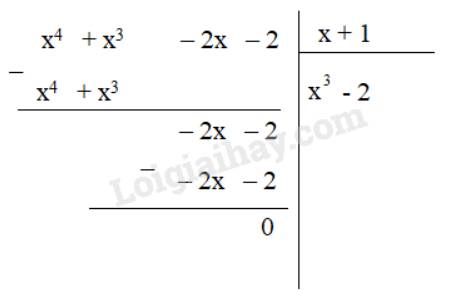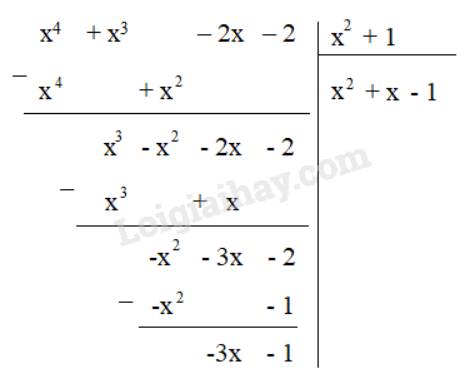
Hãy nhập câu hỏi của bạn vào đây, nếu là tài khoản VIP, bạn sẽ được ưu tiên trả lời.


b, Đặt \(B\left(x\right)=x^2-\dfrac{x}{2}=x\left(x-\dfrac{1}{2}\right)=0\)
\(\Leftrightarrow x=0;x=\dfrac{1}{2}\)Vậy nghiệm đa thức B(x) là x = 0 ; x = 1/2
c, Đặt \(C\left(x\right)=2x^2+4=2\left(x^2+2\right)=0\)
\(\Leftrightarrow\left\{{}\begin{matrix}2\ne0\\x^2=-2\left(voli\right)\end{matrix}\right.\)Vậy đa thức C(x) vô nghiệm
d, Đặt \(D\left(x\right)=3x^4+7=0\Leftrightarrow x^4=-\dfrac{7}{3}\left(voli\right)\)
Vậy đa thức D(x) vô nghiệm

a) Ta có:
B = (A + B) – A
= (x3 + 3x + 1) – (x4 + x3 – 2x – 2)
= x3 + 3x + 1 – x4 - x3 + 2x + 2
= – x4 + (x3 – x3) + (3x + 2x) + (1 + 2)
= – x4 + 5x + 3.
b) C = A - (A – C)
= x4 + x3 – 2x – 2 – x5
= – x5 + x4 + x3 – 2x – 2.
c) D = (2x2 – 3) . A
= (2x2 – 3) . (x4 + x3 – 2x – 2)
= 2x2 . (x4 + x3 – 2x – 2) + (-3) .(x4 + x3 – 2x – 2)
= 2x2 . x4 + 2x2 . x3 + 2x2 . (-2x) + 2x2 . (-2) + (-3). x4 + (-3) . x3 + (-3). (-2x) + (-3). (-2)
= 2x6 + 2x5 – 4x3 – 4x2 – 3x4 – 3x3 + 6x + 6
= 2x6 + 2x5 – 3x4 + (-4x3 – 3x3) – 4x2+ 6x + 6
= 2x6 + 2x5 – 3x4 – 7x3 – 4x2+ 6x + 6.
d) P = A : (x+1) = (x4 + x3 – 2x – 2) : (x + 1)

Vậy P = x3 - 2
e) Q = A : (x2 + 1)
Nếu A chia cho đa thức x2 + 1 không dư thì có một đa thức Q thỏa mãn
Ta thực hiện phép chia (x4 + x3 – 2x – 2) : (x2 + 1)

Do phép chia có dư nên không tồn tại đa thức Q thỏa mãn

\(a,A\left(x\right)=-3x^3+2x^2-6+5x+4x^3-2x^2-4-4x\\ =\left(-3x^3+4x^3\right)+\left(2x^2-2x^2\right)+\left(5x-4x\right)+\left(-6-4\right)\\ =x^3+0+x-10\\ =x^3+x-10\)
Bậc của đa thức : \(3\)
Hệ số cao nhất ứng với hệ số của số mũ cao nhất : \(1\)
b, \(B\left(x\right)=A\left(x\right).\left(x-1\right)\\ =\left(x^3+x-10\right)\left(x-1\right)\\ =x^3.x+x.x-10x-x^3-x+10\\ =x^4+x^2-x^3-10x-x+10\\ =x^4-x^3+x^2-11x+10\)
\(B\left(2\right)=2^4-2^3+2^2-11.2+10=0\)


\(a,A\left(x\right)=-3x^3+2x^2-6+5x+4x^3-2x^2-4-4x\\ =\left(-3x^3+4x^3\right)+\left(2x^2-2x^2\right)+\left(5x-4x\right)+\left(-6-4\right)\\ =x^3+0+x-10\\ =x^3+x-10\)
Bậc của đa thức \(3\)
Hệ số cao nhất là \(1\)
\(b,B\left(x\right)=A\left(x\right).\left(x-1\right)=\left(x^3+x-10\right)\left(x-1\right)\\ =x^3.x+x.x-10x-x^3-x+10\\ =x^4+x^2-x^3-x-10x+10\\ =x^4-x^3+x^2-11x+10\)
Thay \(x=2\) vào \(B\left(x\right)\)
\(=2^4-2^3+2^2-11.2+10\\ =0\)
Vậy tại \(x=2\) thì \(B\left(x\right)=0\)

Do \(Q_{(2)} + Q_{(-1)} = 0\)
\(\Rightarrow 2^2 - 2 . a . 2 + ( -1 )^2 - 2 . a . ( -1 ) = 0\)
\(\Rightarrow 4 - 4a + 1 + 2a=0\)
\(\Rightarrow ( 4 + 1 ) + ( -4a + 2a ) = 0\)
\(\Rightarrow 5 - 2a = 0\)
\(\Rightarrow a = \dfrac{5}{2}\)
Vậy \(a = \dfrac{5}{2}\)
Ta có \(A\left(1\right)=B\left(-2\right)\Leftrightarrow12+2a+a^2=8-\left|2a+3\right|\left(-2\right)+a^2\)
\(\Leftrightarrow4+2a=2\left|2a+3\right|\)
đk a >= -2
\(\left[{}\begin{matrix}4a+6=4+2a\\4a+6=-2a-4\end{matrix}\right.\Leftrightarrow\left[{}\begin{matrix}a=-1\left(tm\right)\\a=-\dfrac{5}{3}\left(ktm\right)\end{matrix}\right.\)